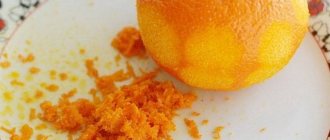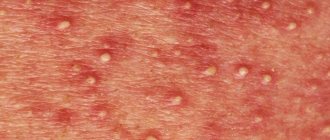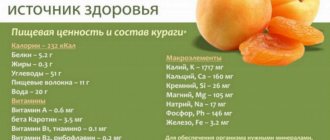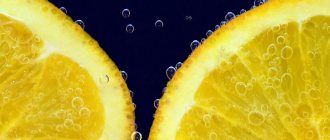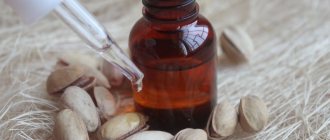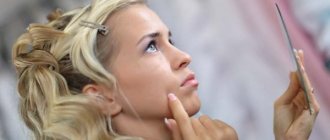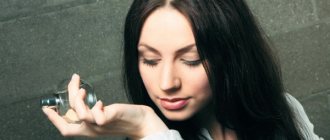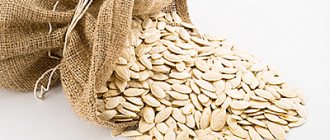General description of the disease
This is a chronic inflammatory skin disease.
It is not life-threatening and does not affect human functionality, but if not properly cared for, it can lead to the appearance of scars on the skin[1]. Let's take a closer look at why acne forms. Sebaceous glands are tiny glands that are located near the surface of the skin. They attach to hair follicles, which are small holes in the skin from which hairs grow.
Sebaceous glands lubricate hair and skin to prevent them from drying out. They do this by producing an oily substance called sebum.
If pimples appear on the skin, this is a sign that the glands have begun to produce too much sebum. Its excess mixes with dead skin cells and forms a plug in the follicle.
If the clogged follicle is close to the surface of the skin, it curves outward, creating a white head.
Normally harmless bacteria that live on the skin can then contaminate and infect the clogged follicles, causing papules, pustules, nodules or cysts[3].
Causes of acne
The cause of acne can be many factors. The most common of them:
- Increased androgen levels in the blood. This is a type of hormone whose levels increase rapidly during puberty. In women, it turns into the hormone estrogen. An increase in the level of androgens in the blood provokes more active work of the sebaceous glands, due to which more sebum is released. It destroys the cell walls in the pores, provokes the growth of bacteria, which is fraught with inflammatory processes on the skin and the formation of acne.
- Taking medications that contain lithium and androgen.
- Using oily cosmetics or those that clog pores.
- Hormonal imbalance in the body.
- Emotional stress.
- Menstruation period[1].
- Heredity – Research shows that a child whose parents have both suffered from acne has a much higher risk of developing acne.
- Pregnancy, especially during the first trimester. At this time, a change in hormone levels occurs in the body, which can cause rashes to appear on the body.
- Polycystic ovary syndrome in women is a common condition that can cause acne, weight gain, and the formation of small cysts inside the ovary
- Wearing objects that are in constant contact with the affected area. For example, a cap, helmet, backpack - this can provoke an increase in the area of the inflammatory process[3].
- Poor nutrition. Research shows that certain foods high in carbohydrates may worsen acne. These include chocolate, chips and other snacks, flour products[4].
Types of acne
- 1 Juvenile acne is a type that occurs most often between the ages of 12 and 16 years. A characteristic symptom is inflammatory areas with small pustules on the face or body due to disruption of the sebaceous glands.
- 2 Comedones are a type of acne that forms when follicles are clogged with hair, sebum, cosmetics, and dead skin particles. May appear as black or white dots.
- 3 Blackheads are a type of open comedones. As a rule, they can be easily removed at home with masks, scrubs and proper care.
- 4 White pimples are closed comedones. They are formed from a pore in which sebum accumulates and does not come out. Because of this, a white dot appears. In itself, it is not dangerous, but if bacteria get into it, it can trigger the development of an inflammatory process.
- 5 Papules are inflamed comedones that look like pink or red dots on the skin. They can cause unpleasant, painful sensations from touch. Attempts to squeeze them out can cause increased inflammation or scarring on the skin.
- 6 Pustules are another type of inflamed acne. It consists of a white head with a red area around it. Over time, it fills with white or yellow pus. Do not squeeze pustules under any circumstances - they may leave behind a scar or dark spot.
- 7 Nodules are large inflamed lumps. They develop deep inside the skin and are very often painful. If this type of acne appears, you should immediately contact a dermatologist.
- 8 Cysts are relatively large lesions that resemble boils. Like nodes, they can be painful and require treatment prescribed by a specialist.
- 9 Acne conglobate is perhaps one of the most severe forms of acne, characterized by a large number of rashes. It includes many inflamed nodules that are connected to each other under the skin. This species can affect the neck, chest, arms and buttocks. It often leaves scars. This type of acne is more common in men and can sometimes be triggered by taking testosterone or steroids[2].
Symptoms
The most common symptoms are the inflammation on the skin itself. These are redness, blackheads or white raised pimples, ulcers. Sometimes they cause unpleasant sensations: pain when pressing, compaction. They can be either in the form of bulges or even [4].
Complications of acne
The most common complication of acne is scars that remain on the skin after squeezing or improper treatment or lack of care. Almost all types of acne can leave behind scars, but they most often occur after the most serious types, cysts and nodules, rupture and affect the skin nearby.
There are three main types of scars that remain after acne and acne:
- 1 Small, deep holes on the surface of the skin that look as if the skin has been pierced with a sharp object.
- 2 Strips of scar tissue that form under the skin, giving its surface an uneven appearance.
- 3 Round or oval depressions in the skin that resemble craters and usually have a slightly distinctive hue.
Such unpleasant consequences can be avoided if you properly care for your skin, treat pimples, and under no circumstances squeeze them out yourself[3].
Common myths related to acne
- Acne appears from poor nutrition. Research has proven that not all “wrong” foods cause rashes. For example, fatty foods do not affect the growth of acne. But working in the kitchen with vats in which food is fried can cause rashes, since microscopic particles of oil can settle on the skin, clog follicles, and cause irritation.
- Acne will not appear if you cleanse your skin every day. In fact, cleansing your skin too often several times a day with chemicals only makes it more vulnerable and causes new breakouts to appear.
- The use of cosmetics leads to the appearance of pimples and new acne. It is a myth. It is important to choose the right cosmetics. Cosmetics that do not contain oil and do not clog pores are especially effective in preventing acne. The main thing is that at the end of the day, be sure to cleanse the skin of makeup, sebaceous gland secretions and dead skin particles[4].
Prevention and care for acne skin
- Wash your face no more than twice a day with warm water and mild soap specifically formulated for problem skin.
- Do not injure the skin with strong friction, aggressive scrubs, or care products.
- Never squeeze pimples; this will cause infection, leading to more clogged areas, swelling and redness.
- Keep your phone away from your face when talking, as there are a lot of bacteria living on its surface.
- Wash your hands frequently, especially before applying lotions, creams, or makeup.
- If acne appears on your back, shoulders, or chest, wear loose clothing to allow your skin to breathe. Avoid tight-fitting synthetic clothing.
- Choose cosmetics for sensitive skin and avoid oil-based products. Remove your makeup before going to bed.
- Keep your hair clean as it accumulates sebum and dead skin particles.
- When shaving, use an electric razor or sharp safety razors. Soften your skin and beard with warm, soapy water before applying shaving cream.
- Avoid anxiety and stress, as this can increase the production of cortisol and adrenaline, which trigger acne.
Treatment of acne in official medicine
Treatment for acne depends on how severe it is. So, you can remove blackheads yourself using a special scrub and masks. Other mild pimples - whiteheads or small amounts of blackheads - can be treated with over-the-counter gels or creams that contain benzene peroxide.
But the treatment of severe acne may take from several weeks to several months. A combination of antibiotics and topical treatment is usually the first option for treating severe acne. If this doesn't work, your doctor may prescribe the drug isotretinoin. Sometimes hormonal pills are also prescribed to combat acne[4].
Diet for acne. Diet menu for acne
Elements such as phosphorus, zinc, calcium, magnesium, and potassium are of great importance for regulating the functioning of the sebaceous glands and the condition of the skin. Therefore, the diet should contain foods containing them in sufficient quantities: phosphorus (fish and seafood, dairy products), potassium (dried fruits - raisins, dried apricots, prunes, various types of cabbage, bananas), calcium (chia seeds, dairy products, sesame seeds), zinc (seafood, veal liver, seaweed, legumes, beef, wheat/rice bran, pumpkin/sesame seeds, poppy seeds).
Equally important when treating acne is the inclusion in the diet of foods rich in vitamins and especially vitamin A (fish oil, cod liver, animal liver, apricots, sorrel, spinach, pumpkin, carrots, cucumbers), vitamin E (all nuts, vegetable oils, avocado, spinach, oatmeal/buckwheat), B6 (garlic, bran, pine nuts, animal liver, mackerel, yeast, sweet pepper, sea buckthorn, tuna, hazelnuts, millet).
For acne, as with other skin diseases, it is recommended to avoid direct sunlight, stressful situations, visits to the sauna and steam bath, and maintain a work-rest schedule. Since many patients with acne suffer from mental status, manifested by an inferiority complex with the development of depression, anxiety, and social maladaptation, consultation with a psychologist is necessary, and in some cases, taking medications to correct such conditions.
The choice of acne treatment methods depends on the individual characteristics of the patient, but in any case includes a set of measures - drug treatment (external therapy, oral medications), gentle cleansing methods and skin care, and adherence to certain nutritional rules. Proper nutrition is an integral part of complex acne therapy and can increase the effectiveness of treatment, achieve stable remission and significantly improve the quality of life.
Nutrition for acne should be special, because the diet itself for acne is not complicated, but very effective for the prevention and treatment of acne. To achieve success in treating the disease, use the suggested tips on proper nutrition for acne!
Allowed products for acne
Return to content
What is stress acne?
Many people do not see the connection between the fact that they are experiencing stress and the appearance of acne from their nerves. Meanwhile, the human body is so complex that skin rashes can occur at the slightest deterioration in health. Emotional acne is far from uncommon.
- Their appearance is based on the production of special biological substances, which have a negative effect on the epidermis:
- activation of metabolic processes;
- increased heat exchange in tissues;
- increased sweat secretion;
- decreased local immunity;
- creating favorable conditions for the proliferation of pathogenic microorganisms.
The natural result of any tense situation for impressionable and suspicious people is stress acne. A competent treatment regimen helps to overcome them - light herbal sedatives are taken internally, while various antiseptic ointments and solutions are taken externally. Thus, zinc, benzoyl peroxide, and retinoids have proven themselves to be excellent. If acne from stress on the body is not eliminated only by taking medications, then it is recommended to seek help from a psychotherapist and learn with him relaxation techniques and auto-training to increase stress resistance.
The prognosis for recovery from acne is favorable. The skin will regain purity and beauty after eliminating the cause that served as the basis for the appearance of the rash.
Nine easy ways to get rid of acne
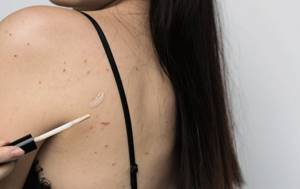
In some cases, identifying the causes of acne is quite easy. It is enough to analyze what changes have occurred in your diet or lifestyle recently. When a trigger is identified, eliminate it for a while and monitor the condition of your skin.
If your actions do not pay off, then you should listen to the advice of doctors:
- Shower more often. And not only after active physical activity, but also in cases when you sweat quite a bit.
- Use antibacterial agents. They perfectly cleanse pores of impurities. Cosmetics containing tea tree oil are ideal. And if you don't have sensitive skin, try using cleansers with salicylic acid or benzoyl peroxide.
- “Clean up” your hair. And when you wash your hair, make sure that the conditioner or balm does not get on your shoulders and shoulder blades. This can contribute to clogged pores.
- Do not use greasy body care products. Use light and moisturizing lotions or creams for your back.
- Change your clothes often. If you are sweating, quickly change your clothes so that the moisture does not have time to come into contact with your skin. This will reduce the likelihood of new acne appearing.
- Give preference to clothes made from natural fabrics. It is difficult to overestimate the advantages of things made from breathable and moisture-wicking cotton and linen.
- Review your diet. Avoid foods with a high glycemic index: white bread, pasta, pastries and potatoes. Replace them with vegetables, fruits, lean meats, whole grain breads and cereals.
- Review your medications. If you suspect a side effect from the drugs, consult your doctor so that he can find an alternative for you.
- Get plenty of rest. Non-nervous rashes are quite common. Protect yourself from stress, learn to relax, and everything will pass.
Causes of skin problems
The most common cause of inflammatory processes in the skin is disruption of the digestive system or improper nutrition. Problems in the intestines negatively affect metabolism, causing constipation. As a result, toxins enter the body and have a detrimental effect on it.
If the gastrointestinal tract does not cope with its cleansing function, then its responsibilities are primarily taken over by the skin and the release of toxins occurs through its pores. First of all, the complexion suffers - an unhealthy gray tint appears. Then acne, inflammation and blackheads appear. First of all, all these manifestations appear on the face and cheeks.
An anti-acne diet helps remove the food factor that causes acne. If it does not help (this happens extremely rarely), then the problem should be looked for in your lifestyle, skin type and hormonal background. In the latter case, you will need serious treatment from an endocrinologist. Before prescribing medications, you will need to donate blood for an extensive analysis. Based on the research results, special medications are prescribed. We recommend that you further adjust your diet so that the effect of treatment becomes noticeable as quickly as possible.
How to get rid
There have been no special scientific studies on the effect of specific foods on the formation of acne.
But still some connection can be traced.
Thus, it has been observed that refined carbohydrates and sugar stimulate the production of sebaceous gland secretions, indirectly through an increase in insulin, which leads to an increase in male sex hormones.
And people who do not have intestinal problems or other gastrointestinal diseases usually do not suffer from acne.
Of course, a healthy diet is just one of the factors that helps fight acne.
Photo: to get rid of rashes, sometimes it’s enough to change your diet
But any doctor will advise starting treatment with diet correction.
Sample menu for the week
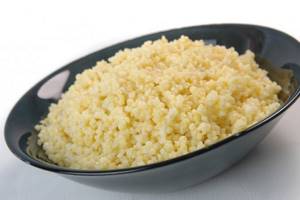
The anti-acne diet differs in that it is not aimed at weight loss and has no contraindications. The menu is built on the principles of proper nutrition, so frying must be replaced with steaming or stewing with minimal addition of oil. Dishes should not contain a lot of salt, and fried vegetables should not be used in soups.
You can create your menu using the example below:
- Monday:
- millet porridge with milk, apple, dried fruit compote (with minimal sugar content);
- borscht with meat (beef), bran or grain bread, tea without sugar;
- steamed or baked fish, carrot and garlic salad.
- Tuesday:
- boiled chicken or quail egg, cottage cheese with berries, tea without sugar;
- chicken broth, boiled chicken breast and vegetables stewed without oil, tomato juice (it’s better to make it yourself);
- buckwheat porridge and steamed chicken breast (you can use boiled one left over from lunch), fresh vegetable salad.
- Wednesday:
- wheat porridge, kefir;
- chicken soup (you can add brown rice or buckwheat to it), grain bread (with bran), fresh berry jelly;
- beef liver stewed with vegetables, dried fruit compote.
- Thursday:
- salad of tomatoes and cheese (can be replaced with Feta cheese), pear, a slice of rye bread, green or herbal tea without sugar;
- pea soup with lean broth, steamed fish, fresh cucumber salad, berry juice;
- cottage cheese, bran, any fruit of your choice, kefir.
- Friday:
- buckwheat porridge with milk, any berries and fruits of your choice, tea to taste without sugar;
- lean beef soup, bran, berry or fruit jelly;
- steamed brown rice, stewed skinless chicken, kefir.
- Saturday:
- a little cheese, cottage cheese with fresh berries or fruits, compote of raisins or dried fruits;
- light broth and a piece of boiled chicken, bran, fresh vegetable salad (choose ingredients to taste);
- steamed or baked fish, beet and prune salad, kefir.
- Sunday:
- steamed minced chicken cutlet, fruit of your choice, herbal or green tea without added sugar;
- borscht with lean beef, a piece of boiled meat (you can use the beef you made the soup with), a small slice of black or grain bread, fresh or stewed vegetables;
- cottage cheese (you can add raisins or dried apricots), bran and drinking yogurt.
When serving dishes, it’s good to sprinkle portions with chopped parsley and add carrots and garlic to salads. The correct dressing for vegetable salads consists of a small amount of flaxseed oil, grated ginger and lemon juice. Choose salmon fish, as it contains amino acids that have a beneficial effect on the skin.
